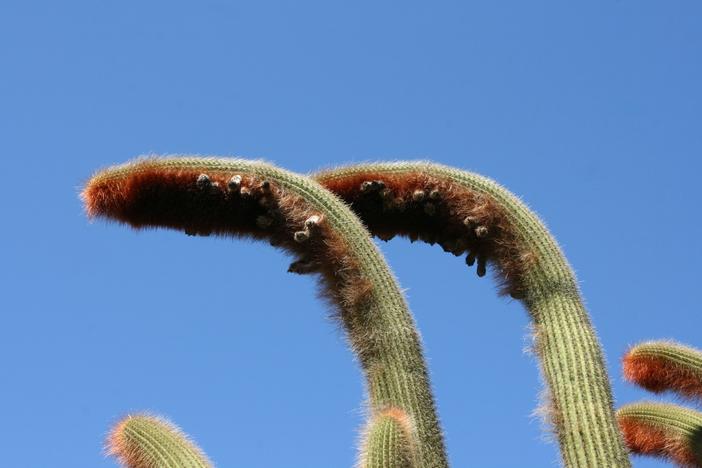Woolly Cactus
(Espostoa guentheri)
Woolly Cactus (Espostoa guentheri)
/
/

Frank Vincentz
CC BY-SA 3.0
Image By:
Frank Vincentz
Recorded By:
Copyright:
CC BY-SA 3.0
Copyright Notice:
Photo by: Frank Vincentz | License Type: CC BY-SA 3.0 | License URL: https://creativecommons.org/licenses/by-sa/3.0 | Uploader: Ies | Publisher: Wikipedia Commons


























Estimated Native Range
Summary
Espostoa guentheri, commonly known as Woolly Cactus, is an evergreen, perennial columnar cactus native to the high-altitude deserts of Bolivia. It is well-adapted to arid environments and rocky outcrops. This cactus can reach up to 2 meters (6 feet 7 inches) in height and is characterized by branching from the base with pale green stems that can be up to 10 centimeters (4 inches) in diameter, featuring about 27 ribs. The Woolly Cactus is notable for its cephalium—a dense, woolly structure from which the flowers emerge—running down from the crown. It blooms in early summer, producing yellowish-white, funnel-shaped flowers that are up to 8 centimeters long and 3 to 5 centimeters (1 to 2 inches) in diameter. The flowers are showy and contrast with the reddish-brown wool of the cephalium. After flowering, it produces edible fruit.
The Woolly Cactus is valued for its unique appearance and is often used as an ornamental plant in xeriscapes and cactus gardens. It requires minimal maintenance and is drought-tolerant, making it suitable for gardeners seeking low-water-use plants. In cultivation, it thrives in full sun and requires soils with fast drainage. While it is generally free from serious pests and diseases, root rot can occur if overwatered. It is not known to be invasive when grown outside its native range, but as with all cacti, care should be taken to prevent escape into natural habitats where it could potentially outcompete native species.CC BY-SA 4.0
The Woolly Cactus is valued for its unique appearance and is often used as an ornamental plant in xeriscapes and cactus gardens. It requires minimal maintenance and is drought-tolerant, making it suitable for gardeners seeking low-water-use plants. In cultivation, it thrives in full sun and requires soils with fast drainage. While it is generally free from serious pests and diseases, root rot can occur if overwatered. It is not known to be invasive when grown outside its native range, but as with all cacti, care should be taken to prevent escape into natural habitats where it could potentially outcompete native species.CC BY-SA 4.0
Plant Description
- Plant Type: Succulent
- Height: 3-6 feet
- Width: 0.5-1 feet
- Growth Rate: Slow
- Flower Color: N/A
- Flowering Season: Spring, Summer
- Leaf Retention: Evergreen
Growth Requirements
- Sun: Full Sun
- Water: Very Low
- Drainage: Fast
Common Uses
Drought Tolerant, Low Maintenance
Natural Habitat
High-altitude deserts of Bolivia
Other Names
Common Names: Cola De Zorro
Scientific Names: , Espostoa guentheri, Vatricania guentheri, Cephalocereus guentheri, Cereus guentheri, Echinopsis guentheri,
GBIF Accepted Name: Espostoa guentheri (Kupper) Buxb. ex Eggli